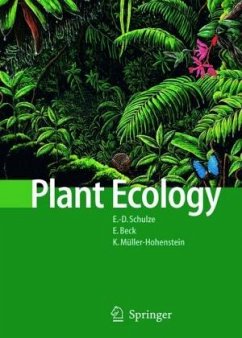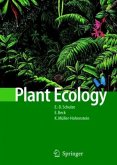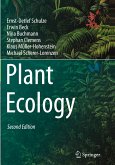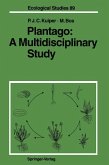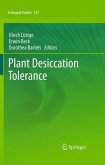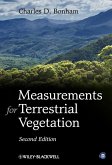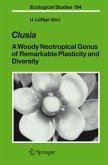This textbook covers Plant Ecology from the molecular to the global level. It covers the following areas in unprecedented breadth and depth:
- Molecular ecophysiology (stress physiology: light, temperature, oxygen deficiency, drought, salt, heavy metals, xenobiotica and biotic stress factors)
- Autecology (whole plant ecology: thermal balance, water, nutrient, carbon relations)
- Ecosystem ecology (plants as part of ecosystems, element cycles, biodiversity)
- Synecology (development of vegetation in time and space, interactions between vegetation and the abiotic and biotic environment)
- Global aspects of plant ecology (global change, global biogeochemical cycles, land use, international conventions, socio-economic interactions)
The book is carefully structured and well written: complex issues are elegantly presented and easily understandable. It contains more than 500 photographs and drawings, mostly in colour, illustrating the fascinating subject.
The book is primarily aimed at graduate students of biology but will also be of interest to post-graduate students and researchers in botany, geosciences and landscape ecology. Further, it provides a sound basis for those dealing with agriculture, forestry, land use, and landscape management.
- Molecular ecophysiology (stress physiology: light, temperature, oxygen deficiency, drought, salt, heavy metals, xenobiotica and biotic stress factors)
- Autecology (whole plant ecology: thermal balance, water, nutrient, carbon relations)
- Ecosystem ecology (plants as part of ecosystems, element cycles, biodiversity)
- Synecology (development of vegetation in time and space, interactions between vegetation and the abiotic and biotic environment)
- Global aspects of plant ecology (global change, global biogeochemical cycles, land use, international conventions, socio-economic interactions)
The book is carefully structured and well written: complex issues are elegantly presented and easily understandable. It contains more than 500 photographs and drawings, mostly in colour, illustrating the fascinating subject.
The book is primarily aimed at graduate students of biology but will also be of interest to post-graduate students and researchers in botany, geosciences and landscape ecology. Further, it provides a sound basis for those dealing with agriculture, forestry, land use, and landscape management.
From the reviews:
"The approach is comprehensive and attempts to cover all aspects of plant ecology from the molecular to ecosystems and global ecology. It succeeds very well and in its 700 pages is found a staggering wealth of information which is extremely good value for money. ... In addition to the general text, there are very useful boxes giving an account in short detail of specific areas. The illustrations are excellent." (Bulletin of the British Ecological Society)
"This is an in-depth and up-to-date textbook of ecology in its broadest sense. The coverage is wide, but also detailed and well explained. ... A strength of the book is that it is abundantly illustrated with many photogrphas, graphs and drawings to explain the more complex issues described in the text. ... Overall, Plant Ecology is a broad-ranging textbook aimed at graduate studetns, postgraduate students and teachers of ecology, which will aslo be of considerable use to researchers in botany, foretry, agriculture and landscape studies. It brings together for the first time in a single text the huge range of topics that fall under plant ecology with an emphasis on the physiological." (Times Higher Education Supplement)
"A substantial reference text for the advanced student ... Here is a courageous attempt to encompass the whole discipline in the broader sense - from biochemical structures and pathways to whole-plant biology and from laboratory to field and socio-economic interactions. ... reviews physiological and whole plant ecology, the ecology of ecosystems and plant communities, including historical apsects of vegetation and plant geography, and human impact and global change in biodiversity and climate. Each chapter points to relevant literature and websites, and over 500 diagrams, tables and colour photographs illustrate the text." (Plant Talk)
"The book is well written and the figures, including many rare photographs covering the whole world. are very impressive. The whole layout is of high quality ... The authors have been very successful in writing a high-standard textbook. ... I recommend this book for graduate students of ecology and geosciences; PhD students and researchers will also use it as a thorough reference for many questions." (Phytocoenologia)
"This large (almost 700 pages), comprehensive and well illustrated book provides interested students and teachers with a large survey of various aspects of plant ecology, covering a large range of spatial and temporal scales. The approach used by the authors is to start at plant level, producing some really up-to-date information on plant stress physiology, and to gradually integrate knowledge at larger scales (whole plant level, followed by ecosystems, phytocenoses, and finally global approaches). Each of the five large chapters provides a really detailed overview of the field ... the present book is a perfect tool to all those interested by gaining a broad overview of a modern form of plant ecology." (Annals of Forest Science)
" ... one of the most comprehensive textbooks of plant ecology so far. The authors aim to 'for the first time bring together and clearly organize the large subdisciplines of plant ecology' and, to a large extent they have succeeded. The book is well written, and its more than 500 illustrations are beautifully laid out and well chosen to help the reader understand the theory. It is clearly suitable not only to its intended public, graduate students in biology, but also for undergraduates, while it provides a very useful reference for researchers in ecology and related fields. .... I find this a excellent textbook. It provides an integrated understanding of plants from the molecular to the global, and in doing so gives plant ecology the place it deserves: a scientific field that will play an increasingly important role in infuencing the decision-making process regarding the sustainable use of our natural environment locally, regionally and world-wide." (Annals of Botany)
"In the more than 700 pages of this volume the various aspects pertaining to plant ecology are thoroughly covered ... . Numerous figures - more than 500 - also make up the volume and many of them are in colour. At the end of the book there is a 24-page subject index. ... The book provides a unique and up-to-date treatment of all aspects of the field of plant ecology, making it ideally suitable as a textbook and reference work for students, researchers and practitioners." (Enrico Rinaldelli, Advances in Horticultural Science, Issue 4, 2006)
"This book provides an authoritative coverage not only of plant ecology in the strict sense, but also of molecular ecophysiology and biogeochemistry. ... The book is carefully structured and well written. Terms are defined clearly and concisely ... . the authors do a good job of cross-referencing material of other sections. ... The book provides a good framework and reference for university teachers ... . I would like to compliment the authorship on having embraced this subject and produced a major work ... ." (Thomas N. Sieber, Schweizerische Zeitschrift für Forstwesen, Vol. 157 (11), 2006)
"This textbook covers plant ecology from the molecular to the global level. ... The book is carefully structured and well written: complex issues are elegantly presented and easily understandable. It contains more than 500 photographs and drawings, mostly in color, illustrating the broad subject. The book is primarily aimed at graduate students of biology but will also be helpful for post-graduate students and researchers ... . Further, it provides a sound basis for those dealing with agriculture, forestry, land use, and landscape management." (K.-H. Feger, Journal of Plant Nutrition and Soil Science, Issue 1, 2006)
"The approach is comprehensive and attempts to cover all aspects of plant ecology from the molecular to ecosystems and global ecology. It succeeds very well and in its 700 pages is found a staggering wealth of information which is extremely good value for money. ... In addition to the general text, there are very useful boxes giving an account in short detail of specific areas. The illustrations are excellent." (Bulletin of the British Ecological Society)
"This is an in-depth and up-to-date textbook of ecology in its broadest sense. The coverage is wide, but also detailed and well explained. ... A strength of the book is that it is abundantly illustrated with many photogrphas, graphs and drawings to explain the more complex issues described in the text. ... Overall, Plant Ecology is a broad-ranging textbook aimed at graduate studetns, postgraduate students and teachers of ecology, which will aslo be of considerable use to researchers in botany, foretry, agriculture and landscape studies. It brings together for the first time in a single text the huge range of topics that fall under plant ecology with an emphasis on the physiological." (Times Higher Education Supplement)
"A substantial reference text for the advanced student ... Here is a courageous attempt to encompass the whole discipline in the broader sense - from biochemical structures and pathways to whole-plant biology and from laboratory to field and socio-economic interactions. ... reviews physiological and whole plant ecology, the ecology of ecosystems and plant communities, including historical apsects of vegetation and plant geography, and human impact and global change in biodiversity and climate. Each chapter points to relevant literature and websites, and over 500 diagrams, tables and colour photographs illustrate the text." (Plant Talk)
"The book is well written and the figures, including many rare photographs covering the whole world. are very impressive. The whole layout is of high quality ... The authors have been very successful in writing a high-standard textbook. ... I recommend this book for graduate students of ecology and geosciences; PhD students and researchers will also use it as a thorough reference for many questions." (Phytocoenologia)
"This large (almost 700 pages), comprehensive and well illustrated book provides interested students and teachers with a large survey of various aspects of plant ecology, covering a large range of spatial and temporal scales. The approach used by the authors is to start at plant level, producing some really up-to-date information on plant stress physiology, and to gradually integrate knowledge at larger scales (whole plant level, followed by ecosystems, phytocenoses, and finally global approaches). Each of the five large chapters provides a really detailed overview of the field ... the present book is a perfect tool to all those interested by gaining a broad overview of a modern form of plant ecology." (Annals of Forest Science)
" ... one of the most comprehensive textbooks of plant ecology so far. The authors aim to 'for the first time bring together and clearly organize the large subdisciplines of plant ecology' and, to a large extent they have succeeded. The book is well written, and its more than 500 illustrations are beautifully laid out and well chosen to help the reader understand the theory. It is clearly suitable not only to its intended public, graduate students in biology, but also for undergraduates, while it provides a very useful reference for researchers in ecology and related fields. .... I find this a excellent textbook. It provides an integrated understanding of plants from the molecular to the global, and in doing so gives plant ecology the place it deserves: a scientific field that will play an increasingly important role in infuencing the decision-making process regarding the sustainable use of our natural environment locally, regionally and world-wide." (Annals of Botany)
"In the more than 700 pages of this volume the various aspects pertaining to plant ecology are thoroughly covered ... . Numerous figures - more than 500 - also make up the volume and many of them are in colour. At the end of the book there is a 24-page subject index. ... The book provides a unique and up-to-date treatment of all aspects of the field of plant ecology, making it ideally suitable as a textbook and reference work for students, researchers and practitioners." (Enrico Rinaldelli, Advances in Horticultural Science, Issue 4, 2006)
"This book provides an authoritative coverage not only of plant ecology in the strict sense, but also of molecular ecophysiology and biogeochemistry. ... The book is carefully structured and well written. Terms are defined clearly and concisely ... . the authors do a good job of cross-referencing material of other sections. ... The book provides a good framework and reference for university teachers ... . I would like to compliment the authorship on having embraced this subject and produced a major work ... ." (Thomas N. Sieber, Schweizerische Zeitschrift für Forstwesen, Vol. 157 (11), 2006)
"This textbook covers plant ecology from the molecular to the global level. ... The book is carefully structured and well written: complex issues are elegantly presented and easily understandable. It contains more than 500 photographs and drawings, mostly in color, illustrating the broad subject. The book is primarily aimed at graduate students of biology but will also be helpful for post-graduate students and researchers ... . Further, it provides a sound basis for those dealing with agriculture, forestry, land use, and landscape management." (K.-H. Feger, Journal of Plant Nutrition and Soil Science, Issue 1, 2006)
y, agriculture and landscape studies. It brings together for the first time in a single text the huge range of topics that fall under plant ecology with an emphasis on the physiological." (Times Higher Education Supplement)
"A substantial reference text for the advanced student ... Here is a courageous attempt to encompass the whole discipline in the broader sense - from biochemical structures and pathways to whole-plant biology and from laboratory to field and socio-economic interactions. ... reviews physiological and whole plant ecology, the ecology of ecosystems and plant communities, including historical apsects of vegetation and plant geography, and human impact and global change in biodiversity and climate. Each chapter points to relevant literature and websites, and over 500 diagrams, tables and colour photographs illustrate the text." (Plant Talk)
"The book is well written and the figures, including many rare photographs covering the whole world. are very impressive. The whole layout is of high quality ... The authors have been very successful in writing a high-standard textbook. ... I recommend this book for graduate students of ecology and geosciences; PhD students and researchers will also use it as a thorough reference for many questions." (Phytocoenologia)
"This large (almost 700 pages), comprehensive and well illustrated book provides interested students and teachers with a large survey of various aspects of plant ecology, covering a large range of spatial and temporal scales. The approach used by the authors is to start at plant level, producing some really up-to-date information on plant stress physiology, and to gradually integrate knowledge at larger scales (whole plant level, followed by ecosystems, phytocenoses, and finally global approaches). Each of the five large chapters provides a really detailed overview of the field ... the present book is a perfect tool to all those interested by gaining a broad overview of a modern form of plant ecology." (Annals of Forest Science)
" ... one of the most comprehensive textbooks of plant ecology so far. The authors aim to 'for the first time bring together and clearly organize the large subdisciplines of plant ecology' and, to a large extent they have succeeded. The book is well written, and its more than 500 illustrations are beautifully laid out and well chosen to help the reader understand the theory. It is clearly suitable not only to its intended public, graduate students in biology, but also for undergraduates, while it provides a very useful reference for researchers in ecology and related fields. .... I find this a excellent textbook. It provides an integrated understanding of plants from the molecular to the global, and in doing so gives plant ecology the place it deserves: a scientific field that will play an increasingly important role in infuencing the decision-making process regarding the sustainable use of our natural environment locally, regionally and world-wide." (Annals of Botany)
"In the more than 700 pages of this volume the various aspects pertaining to plant ecology are thoroughly covered ... . Numerous figures - more than 500 - also make up the volume and many of them are in colour. At the end of the book there is a 24-page subject index. ... The book provides a unique and up-to-date treatment of all aspects of the field of plant ecology, making it ideally suitable as a textbook and reference work for students, researchers and practitioners." (Enrico Rinaldelli, Advances in Horticultural Science, Issue 4, 2006)
"This book provides an authoritative coverage not only of plant ecology in the strict sense, but also of molecular ecophysiology and biogeochemistry. ... The book is carefully structured and well written. Terms are defined clearly and concisely ... . the authors do a good job of cross-referencing material of other sections. ... The book provides a good framework and reference for university teachers ... . I would like t
"A substantial reference text for the advanced student ... Here is a courageous attempt to encompass the whole discipline in the broader sense - from biochemical structures and pathways to whole-plant biology and from laboratory to field and socio-economic interactions. ... reviews physiological and whole plant ecology, the ecology of ecosystems and plant communities, including historical apsects of vegetation and plant geography, and human impact and global change in biodiversity and climate. Each chapter points to relevant literature and websites, and over 500 diagrams, tables and colour photographs illustrate the text." (Plant Talk)
"The book is well written and the figures, including many rare photographs covering the whole world. are very impressive. The whole layout is of high quality ... The authors have been very successful in writing a high-standard textbook. ... I recommend this book for graduate students of ecology and geosciences; PhD students and researchers will also use it as a thorough reference for many questions." (Phytocoenologia)
"This large (almost 700 pages), comprehensive and well illustrated book provides interested students and teachers with a large survey of various aspects of plant ecology, covering a large range of spatial and temporal scales. The approach used by the authors is to start at plant level, producing some really up-to-date information on plant stress physiology, and to gradually integrate knowledge at larger scales (whole plant level, followed by ecosystems, phytocenoses, and finally global approaches). Each of the five large chapters provides a really detailed overview of the field ... the present book is a perfect tool to all those interested by gaining a broad overview of a modern form of plant ecology." (Annals of Forest Science)
" ... one of the most comprehensive textbooks of plant ecology so far. The authors aim to 'for the first time bring together and clearly organize the large subdisciplines of plant ecology' and, to a large extent they have succeeded. The book is well written, and its more than 500 illustrations are beautifully laid out and well chosen to help the reader understand the theory. It is clearly suitable not only to its intended public, graduate students in biology, but also for undergraduates, while it provides a very useful reference for researchers in ecology and related fields. .... I find this a excellent textbook. It provides an integrated understanding of plants from the molecular to the global, and in doing so gives plant ecology the place it deserves: a scientific field that will play an increasingly important role in infuencing the decision-making process regarding the sustainable use of our natural environment locally, regionally and world-wide." (Annals of Botany)
"In the more than 700 pages of this volume the various aspects pertaining to plant ecology are thoroughly covered ... . Numerous figures - more than 500 - also make up the volume and many of them are in colour. At the end of the book there is a 24-page subject index. ... The book provides a unique and up-to-date treatment of all aspects of the field of plant ecology, making it ideally suitable as a textbook and reference work for students, researchers and practitioners." (Enrico Rinaldelli, Advances in Horticultural Science, Issue 4, 2006)
"This book provides an authoritative coverage not only of plant ecology in the strict sense, but also of molecular ecophysiology and biogeochemistry. ... The book is carefully structured and well written. Terms are defined clearly and concisely ... . the authors do a good job of cross-referencing material of other sections. ... The book provides a good framework and reference for university teachers ... . I would like t

